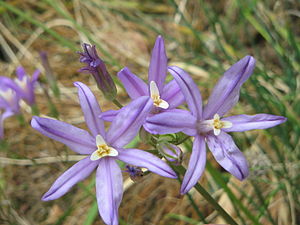Brodiaea californica
| Brodiaea californica | ||||||||||||
|---|---|---|---|---|---|---|---|---|---|---|---|---|

Brodiaea californica |
||||||||||||
| Systematics | ||||||||||||
|
||||||||||||
| Scientific name | ||||||||||||
| Brodiaea californica | ||||||||||||
| Lindl. |
Brodiaea californica is a species of the genus Brodiaea in the asparagus family (Asparagaceae). The two subspecies are only found in the western US states of California and Oregon.
description
Vegetative characteristics
Brodiaea californica grows as perennial herbaceous plants . Plant tubers are formed as persistence organs . One to six narrow leaves are produced per tuber during the growing season.
Generative characteristics
The strong inflorescence stem is 20 to 70 centimeters long. At the end of the inflorescence stem there is an open, golden inflorescence . The bracts also covers during the inflorescence still in bud one is not complete. There are also cover sheets . The flower stalk is 2 to 10 centimeters long.
The hermaphrodite flowers are radial symmetry and threefold. There are two circles, each with three bracts , which are fused at their base. The three outer bracts are slightly narrower than the inner three. The six light pink or sometimes white bracts are fused to form a cylindrical, translucent flower tube with a length of 9 to 12 millimeters, which also pops open until the fruit is ripe. The corolla is a total of 24 to 38 millimeters long and the free part of the bracts is usually more than twice as long as the flower tube. The free part of the bracts is spread out at a length of 20 to 30 millimeters and a width of 4 to 10 millimeters and bent back at the upper end. In Brodiaea californica there are three sterile stamens, i.e. staminodes , that are fused with the bloom bracts and resemble small petals and each face the outer bracts. In the upright, mostly flat, white or light purple-colored and narrow-linear staminodes with a length of 16 to 27 millimeters, the edges are 1/4 to 1/2 rolled up and the upper end is rounded. The staminodes and the stamens are about the same length. The three fertile stamens are located opposite the inner bracts and also at the base of the inflorescence. The base of the 7 to 10 millimeter long stamens is widespread, but does not form triangular wings and, if at all, only rudimentary appendages are present. The size and shape of the stamens and the structures at the base of the stamens are important determinants for the Brodiaea species. The anthers are linear with a length of 9 to 12 millimeters with a rounded upper end. Three carpels long to a 5 to 11 millimeters, three crests membered ovary grown. The 15 to 23 millimeter long stylus ends in a three-lobed scar .
The egg-shaped capsule fruits open in folds = loculicide. The seeds are black.
Systematics and distribution
The first description of Brodiaea californica was made in 1949 by John Lindley in the Journal of the Horticultural Society of London , Volume 4, page 84. A synonym of Brodiaea californica Lindl. is Hookera californica (Lindl.) Greene .
From Brodiaea californica has been around since 2001, two subspecies:
- Brodiaea californica Lindl. ex Lem. subsp. californica : It occurs only in northern California. It thrives in the foothills, on grasslands, in open woodlands, on stony loam soils at altitudes from 0 to 800 meters. Occurrences in Oregon are not proven.
- Brodiaea californica subsp. leptandra (Greene) JCPires (Syn .: Brodiaea californica var. leptandra (Greene) Hoover , Hookera leptandra Greene , Brodiaea leptandra (Greene) Baker , Hookera synandra A.Heller , Brodiaea synandra (A.Heller) Jeps. ): She has since 2001 the rank of a subspecies. It occurs only in the California counties of Lake County , Napa County and Sonoma County . It thrives in open evergreen forests, chaparral, on stony loam soils, often over serpentine rock at altitudes of 0 to 900 meters only in the coastal mountains of northern California. It is considered by some authors as the species Brodiaea leptandra (Greene) Baker .
Individual evidence
- ↑ a b c d e Rafaël Govaerts (Ed.): Brodiaea californica. In: World Checklist of Selected Plant Families (WCSP) - The Board of Trustees of the Royal Botanic Gardens, Kew . Retrieved December 29, 2019.
- ↑ a b c d e f g J. Chris Pires: In: Flora of North America Editorial Committee (Ed.): Flora of North America North of Mexico. Volume 26: Magnoliophyta: Liliidae: Liliales and Orchidales , Oxford University Press, New York and Oxford, 2002, ISBN 0-19-515208-5 . Brodiaea californica , pp. 322–223 - the same text online as the printed work .
- ↑ Brodiaea californica in the Germplasm Resources Information Network (GRIN), USDA , ARS , National Genetic Resources Program. National Germplasm Resources Laboratory, Beltsville, Maryland. Retrieved December 29, 2019.
- ↑ a b Brodiaea californica at Tropicos.org. Missouri Botanical Garden, St. Louis, accessed December 29, 2019.
- ↑ J. Chris Pires, Robert E. Preston: Brodiaea , 2012: Brodiaea californica data sheet in Jepson Flora Project (ed.): Jepson eFlora .
- ↑ J. Chris Pires, Robert E. Preston: Brodiaea , 2012: Brodiaea leptandra data sheet in Jepson Flora Project (ed.): Jepson eFlora .
Web links
- Data sheet of Brodiaea californica at Pacific Bulb Society with detailed photos. last accessed on December 29, 2019.
- USDA profiles with distribution map.
- Digitized herbarium specimens from representatives of the genus Brodiaea .
- Data sheet of Brodiaea californica at Calflora Database with distribution map and photos.


